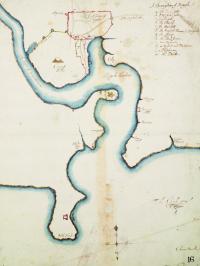Prince Rupert’s royalist navy blockaded at Kinsale
Published in Early Modern History (1500–1700), Features, Issue 4 (July/August 2011), Volume 19
Map of Kinsale, 1649.
(National Maritime Museum, London)
In 1648 a revolt broke out among the fleet stationed in the Downs and a number of ships defected to the royalists in Holland. Prince Rupert (right), the king’s nephew and an experienced soldier, took command of the ships. In January 1649 the prince led a flotilla of seven warships from Helvoetsluys to Kinsale. Following the execution of Charles I on 30 January 1649, parliament began preparations for the reconquest of Ireland. In April they appointed Oliver Cromwell as commander-in-chief for the expedition. The most immediate threat to any invasion force came from the presence of the royalist fleet at Kinsale. To eliminate this danger, parliament selected three new naval commanders—Robert Blake, Richard Deane and Edward Popham, called the ‘generals-at-sea’—to organise the navy. In late May 1649 the generals arrived before Kinsale and proceeded to blockade the royalist fleet in the harbour. A shortage of money and mariners combined with the near-mutinous state of some of his men meant that Rupert could not risk taking his ships out to engage the parliamentarians. At the same time, shore-based fortifications and artillery prevented the generals from assaulting the royalist ships at anchor. Nevertheless, this effective blockade of the royalist squadron at Kinsale allowed the invasion army to cross the Irish Sea safely.

Prince Rupert
Rupert feared the loss of the royalist fleet if he remained there, and in late October he took advantage of a storm to escape with most of his ships to Portugal.
















